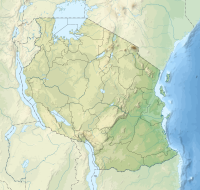| Pangavini Island | |
|---|---|
 Pangavini Island | |
| Location | Dar es Salaam Region, Kinondoni District |
| Nearest city | Dar es Salaam |
| Coordinates | 6°40′29″S 39°14′20″E / 6.6747°S 39.239°E |
| Area | 2.13km² |
| Established | 1975 |
| Governing body | Marine Parks & Reserves Authority (Tanzania) |
| Website | DMRS |
Pangavini Island (Kisiwa cha Pangavini, in Swahili) is a protected, uninhabited island under the Dar es Salaam Marine Reserve with the IUCN category II located within Kinondoni District of Dar es Salaam Region in Tanzania. The island reserve measures around 2.13km2. Pangavini is the smallest island in the group, only about 250 m long; it has a rocky coastline without beaches. To the west of the island is Kunduchi ward and to the north is Mbudya Island. To the south of the island is Bongoyo Island.[1][2]
Overview[edit]
The island protects a variety of vital tropical habitats and biological diversity, including seagrass beds, coral reefs, and several fish species. The beauty of Pangavini Island is that it is the nightly habitat for the majority of the birds that huddle above Dar es Salaam metropolis during the day. Additionally, it serves as the birds' nesting habitat. Additionally, migratory birds can use the reserves as a rest stop on their way south from the winter. A variety of rats, birds, and reptiles use Pangavini Island as a breeding, resting, and feeding ground. Due to the excellent diving and snorkelling conditions and the abundance of sea grass beds within the reserve area, the region is special.[3] The island is home to endangered coconunt crabs. [4]
See also[edit]
References[edit]
- ^ "Marine Parks and Marine Reserves of Tanzania". Retrieved 2020-09-07.
- ^ Levine, Arielle. (2010). Local Responses to Marine Conservation in Zanzibar, Tanzania. Journal of International Wildlife Law and Policy. July–December 2004. 183-202. 10.1080/13880290490883241
- ^ "Pangavini Island Marine Reserve". Retrieved 2020-09-07.
- ^ Caro, Tim, et al. "A case study of the coconut crab Birgus latro on Zanzibar highlights global threats and conservation solutions." Oryx 55.4 (2021): 556-563.

Well, that’s interesting to know that Psilotum nudum are known as whisk ferns. Psilotum nudum is the commoner species of the two. While the P. flaccidum is a rare species and is found in the tropical islands. Both the species are usually epiphytic in habit and grow upon tree ferns. These species may also be terrestrial and grow in humus or in the crevices of the rocks.
View the detailed Guide of Psilotum nudum: Detailed Study Of Psilotum Nudum (Whisk Fern), Classification, Anatomy, Reproduction